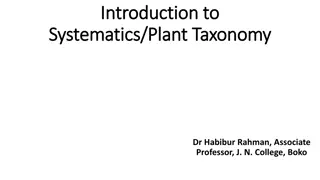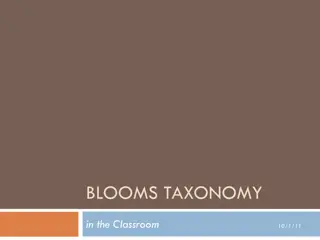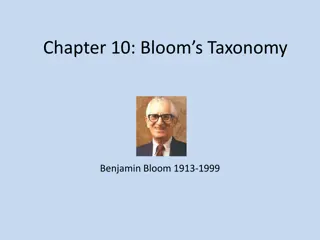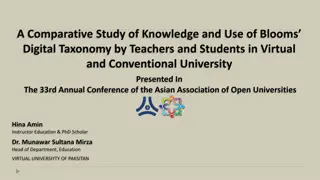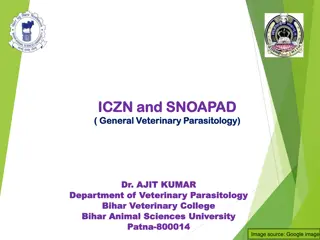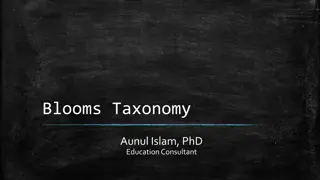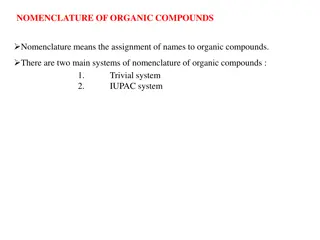Fundamentals of Taxonomy Explained: From Classification to Nomenclature
Taxonomy, derived from Greek roots, encompasses the science of classifying organisms and understanding their variations, evolutionary relationships, and naming conventions. It involves description, identification, classification, and nomenclature of both living and extinct organisms. The practices of taxonomy include assigning features, identifying specimens, ordering organisms into groups based on relationships, and naming taxonomic groups in standardized systems. Different Codes of Nomenclature ensure the use of scientific names. Taxonomy and Systematics together delve into evolutionary relatedness and the formation of new species, combining traditional taxonomic activities with phylogenetic analyses.
Download Presentation

Please find below an Image/Link to download the presentation.
The content on the website is provided AS IS for your information and personal use only. It may not be sold, licensed, or shared on other websites without obtaining consent from the author. Download presentation by click this link. If you encounter any issues during the download, it is possible that the publisher has removed the file from their server.
E N D
Presentation Transcript
PRINCIPLES OF TAXONOMY Linnaeus, Carolus (BIOL3063)
Unit 1. Introduction to Taxonomy Taxonomy is derived from the Greek words taxis="arrangement/to classify;" nomos = law or science Definitions: Taxonomy: the science of classification of organisms (from its origin = narrow definition) Taxonomy: the study of variation + sources of variation + consequences of variation + classification/the principles underlying classification + discovering & naming of organisms/groups of organisms.(Broad definition)
Contemporary definition of taxonomy Taxonomy: the science that involves description, identification, classification and nomenclature of organisms/ taxonomic groups (the most accepted), and Deals with both living and extinct organisms. Naming, describing & classifying living organisms are natural & integral activity of humans. Without such knowledge, it would be difficult to communicate.
Practices of Taxonomy Description: assignment of features to an organism Identification: assignment of one single organism or specimen to an existing classification (taxa produced) Classification: ordering of organisms into groups on the basis of their r/ship. Nomenclature: naming of taxonomic groups/taxa according to some standardized system (i.e. allocation of name of the taxa produced) N.B: Classification precedes nomenclature.
Accordingly, there are about five different Codes of Nomenclature. ICBN, ICZN, International Code of Nomenclature for Cultivated Plants (ICNCP) International Code of Nomenclature of Bacteria (ICNB). International Code of Virus Classification (Draft) Names that are given to organisms/taxa by obeying nomenclatural code are called scientific names.
Taxonomy and Systematics Taxonomy: the science that deals with description, identification, classification & nomenclature of taxa. Systematics: taxonomy + study of evolutionary relatedness among various groups of organisms/phylogenetic analysis Includes both the traditional activities of taxonomy and investigations of evolutionary relationships, variations and speciation (formation of new species).
Importance of Taxonomy Taxonomy is an important science, and is basic to all biological disciplines since each requires the correct names and descriptions of the organisms being studied. It is also dependent on the information provided by other disciplines, such as genetics, physiology, ecology and anatomy.
Classification systems serve four important roles: They do aid to memory. Classification systems greatly improve our predictive powers. Improve our ability to explain relationships among organisms. Provide relatively stable, unique, and unequivocal names for organisms/taxa.
The scope of taxonomy The scope of taxonomy and that of systematics in particular are: 1. It works out a vivid picture of the existing organic diversity of our earth and is the only science that does so. 2. It provides much of the information, for the reconstruction of the phylogeny of life. 3. It reveals various interesting evolutionary phenomena, making them available for casual study by other branches of biology. 4. Almost entirely, it supplies information needed by the various branches of biology.
Scope of taxonomy 5. It provides names for each kind of organism, so that all concerned can know what they are talking about and such information can be recorded, stored and retrieved when needed. 6. It differentiates the various kinds of organisms and points out their characteristics through descriptions, keys, illustrations etc. 7. It provides classification, which are of great heuristic and explanatory values in most branches of biology like evolutionary biochemistry, immunology, ecology, genetics, ethology, historical geology etc.
Scope of taxonomy 8. It is important in the study of economically or medically important organisms. 9. It makes important conceptual contributions in population thinking, thereby making it accessible to experimental biologists. It thus contributes significantly to the broadening of biology and to a better balance within biological science as a whole
Objectives of Taxonomy Taxonomy aims at fulfilling three main objectives 1. Taxonomy aims at classifying organisms into taxa on the basis of similarities in phenotypic (phenetic) characteristics 2. To assign each taxon a name. This naming of a taxon is known as nomenclature 3. To serve as an instrument for identification of bacteria. A newly isolated organism can be assorted to its nearest allies or can be identified as a new hitherto unknown taxon
Levels of Taxonomy (alpha), (beta) and (gamma) taxonomy: Alpha ( ) taxonomy: Alpha ( ) taxonomy is the analytic phase in which the species are identified, characterized and named. At this level when a new species is discovered it is named in accordance with Linnaeus system of binomial nomenclature. Priority is given to the one who publishes his work first All problems relating to species are dealt.
Beta () taxonomy Beta ( ) taxonomy refers to the arrangement of the species into a natural system of hierarchial categories. This is done on the basis of easily observable, shared, structural features and evaluation of numerous characters. Thus, -taxonomy relates to the search of a natural system of classification. Each taxon would thus possess diagnostic features unique to that taxon.
Gamma () taxonomy: Finally, gamma ( ) taxonomy designates the analysis of intraspecific variations and evolutionary studies. Much attention is given to a causal interpretation of organic diversity study of speciation. There are only a few groups of animals (some vertebrates, especially the birds and a few insect orders like Lepidoptera etc.) where the taxonomy has reached up to the gamma level. Otherwise, in almost majority of the groups, the Works are still at the alpha and beta level
Phases of Developmental Stages of Taxonomy A. Pre-Linnaean Taxonomy i. Ancient taxonomy Ancient people have grouped/ categorized living things into groups & gave common/vernacular names. E.g. Identifying edible plants & animals and non-edible ones, useful and harmful organisms, and aggressive and non-aggressive wild animals in their environment, and giving names are as old as human races. This system is called folk taxonomy.
It is important for communication of the people. In such system of classification, organisms that were obvious (common) or more important (useful or harmful) to the people got names while the others might not. The system is characterized by existence & non-existence of vernacular names for organisms/groups of them. Folk taxonomy is characterized by existent & no-existent of common names. One can say that taxonomy is as old as the language skill of mankind.
ii. Taxonomy during the Greek and Roman Philosophers-Essentialists a. Aristotle (384 322 BC) the first to classify living things into plants & animals Animals: into animals with blood & animals without blood animals with blood: live-bearing & egg-bearing, Without blood: insects, crustacea and testacea (molluscs) b. Theophrastus (370 285 BC) Classified of all known plants during the time, De Historia Plantarum, which contained 480 species. His plant classification was based on growth form: tree, shrub/herb Many of his plant genera like Narcissus, Crocus & Cornus still in use.
c. Dioscorides (4090 AD)- Greek physician De Materia Medica 600 plant species. Used in medicine until the 16th C classification based on medicinal properties d. Plinius (23 79 AD) Wrote many books, the only survived is Naturalis Historia Described several plants & gave them Latin names. Many of these names are stil in use (e.g. Populus alba & Populus nigra) Some call him the Father of Botanical Latin.
iii. Middle Age /Medieval Period (5th to 15th C) Little/no progress in botanical & zoological investigation Europe & Asia = famine, endemics (=Dark Age) during this period. Mostly copying & recopying of earlier manuscripts + errors Albertus Magnus (1200-1280) -famous plant taxonomist Doctor of Universalis / Aristotle of the Middle Age Recognized monocots+dicots; vascular + no-vascular
Herbalists time (16 C): publications of several books on medicinal uses of plants. After the Middle Age, taxonomy was influenced by two occasions: Innovation of printing machine & development of science of navigation. 15th century was the onset of Renaissance in Europe. A. Innovation of printing machine: eased printing efforts promoted the publication of many medicinal oriented books, particularly in the next century. lowered prices of books
Medicinal oriented book are said to be Herbals & the authors of such books are Herbalists. 16th century is called the time of great herbalists. e. g. Otto Brunfels, Jerome Bock & Leonart Fuchs whom named the German fathers of botany Herbals exhibit excellent illustrations and detailed descriptions of plants. However, didn t emphasize on any system of classification Plants simply arranged in alphabetical/medicinal uses in herbals.
B. Innovation of Navigation Enabled sailors/investigators to go on long voyages. Exploration of several new areas of the world by crossing large water bodies and collection of new plants and animals. Increased man s practical knowledge taxonomy. V. Early taxonomists- study of living things for basic knowledge Until end of 16th C, existing studies couldn t replace the ideas of ancient Greek philosophers. Discovery of optic lenses & growth of science in 17th C Emphasis was turned from medical aspects to taxonomic aspects; this means, scientists started to study living things for intrinsic purposes instead of only for food and medicinal uses.
a. Caesalpino (15191603) in Italy Some call him the first taxonomist". He wrote De Plantis (1583,) which contained 1500 spp. His classification based on growth habit + fruit, seed, ovaries and their position. Some of the names given by him are still in use . e.g The names for plant families, Brassicaceae and Asteraceae, have been given by Caesalpino.
b. Caspar Bauhin -Swiss botanist Travelled extensively to collect plant specimens and formed a herbarium of 4000 specimens. Published Pinax Theatri Botanici (1623) which contained a list of 6000 plants spp. He also introduced binomial nomenclature (writing species name in two words) for several species. He sought to clarify in a single publication the confusion regarding the multiplicity of names for all species known at that time.
Although he did not describe genera, He recognized the differences between species and genera, and several species were included under the same generic names. Jean Bauhin (1541-1613)-elder brother of C. Bauhin Compiled a description of 5000 plant spp. with more >3500 figures The work of J. Bauhin was published under the name Historia Plantarum Universalis in 1650-1651, several years after his death.
c. John Ray (16271705)- English naturalist Wrote several important works His most important contribution was the establishment of species as the ultimate unit of taxonomy. Methodus Plantarum Nova (1682) 18 000 plant species His classification was based on many combined characters - more natural than the work of earliest taxonomists. Ray aimed at publishing a complete system of nature, which included works on mammals, reptiles, birds, fishes and insects.
d. de Tournefort (16561708)- Franch Botanical classification ruled until time of Carl Linnaeus. Institutiones Rei Herbariae ( 1700 ) = 9000 spp in 698 genera. primary emphasis on the classification genera Classification based on floral characters.
B. Linnaean Era (1707-1778) -Sexual sysytem starting points of modern taxonomy Binary form of species names ("trivial names ) for both plants & animals. i. Species Plantarum(1753) Starting point for botanical names Used "trivial names" (binomial name) for all plant spp. ii. Systema Naturae (1758, 10th ed.) Used "trivial names" (binomial name) for all animal spp.
He used both trivial and phrasal names (up to 12 words) in his publications Soon, binomial names replaced the phrasal names But his classification was based on sexual parts of a flower Recognized 24 classes of plants based on number of stamens. Classes subdivided into orders on bases of carpel. e.g. Monogynia, Digynia, etc. Such classification is sexual system =Artificial system Plant & animal name published before 1753 & 1758, respectively, are called "prelinnaean" = not valid. Early names published by Linnaeus himself before these periods are "prelinnaean"! Pre-Linnaean + Linnaeus =Essentialists& Artificial system binomial name-still in use, but Linaeus classification system is artificial
C. Post-Linnaean Taxonomy i. Foundation Natural System of Classification Different taxonomists criticized classification of Linnaeus= for being artificial, particularly French scientists. a. Georges de Buffon (1707 1788) - strong critic to Linnaeus work Considered classification by Linnaeus as artificial order on the disorderly world. Buffon s aim was to describe the world rather than to classify it. His theories touched with the development of species, intraspecific variety & acquired inherited characters in species Opened pathway for an evolutionary theory.
b. Michel Adanson (17271806) Familles des Plantes already in 1763. Launched the idea that in classification one should : Use as many characters as possible Characters should be given equal weight/no priority and Classification depends on overall similarity Such classification is said to be called Natural classification.
c. Antoine L. de Jussieu (17481836) Estabilished family rank b/n genus and class Acotyledons, Monocotyledons and Dicotyledons d. B.P. de Lamarck (1744 1829) Theory of inheritance of acquired characters ="Lamarckism". Opened path for evolution theory (Charles Darwin & Wallace, 1858) ii. Formation of nomenclatural code (ICBN & ICZN) First attempt to create botanical nomenclatural code = by de Candole in 1813.
Published names should have priority starting Linnaeus On a congress in Paris, 100 botanists adopted the rules in a book by the son of Alphons de Candolle (1806 1873), Lois de Nomenclature Adoptee from 1867. On congress in Vienna (1905) starting date was set to 1753 (Species Plantrum) In 1907, Americans created their own code In 1935, both codes merged together by agreement & formed ICBN.
Initiation of a zoological code started somewhat later. In 1842 a British ornithologist Hugh E. Strickland (1811 1853) elaborated the first nomenclatural laws for zoology, the "Strickland Code".
iii.Natural system developed to Numerical Taxonomy/ Phenetics- phenogram Michel Adanson was published Familles des in 1763 and forwarded the idea that classification should depend on many characters with equal weight=overall similarity. With the development of computer softwares (1960s)/cluster analysis by computer software numerical taxonomy/ phenetics became popular Principles of Numerical Taxonomy by Senath & Sokal (1963 & 1973) & it is the new method of organizing data of N/S & obtaining a classification.
v. Phylogenetics/cladistics Charles Darwin (1809 1882) launched the evolutionary theory in 1858. However, this did not affect systematics in the beginning. Ernst Haeckel (1834 1919) and August W. Eichler (1839 18878) were two German biologists who started the construction of evolutionary trees. Haeckel established the term "phylogeny". However, the main part of the 20th century was dominated by extended phenetics (i.e., looking for overall similarities and differences to create classification).
The German biologist Willi Hennig (19131976) founded the cladistic era in 1966, by stating that only similarities in derived characters (synapomorphies) should be used in classification of species, and that taxa should include all descendants from one single ancestor (the rule of monophyly).


